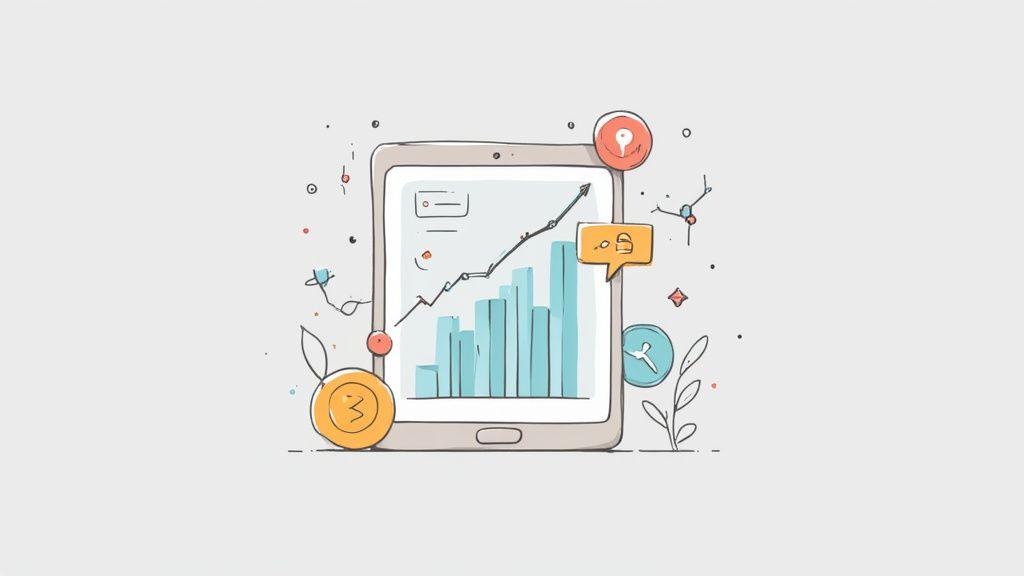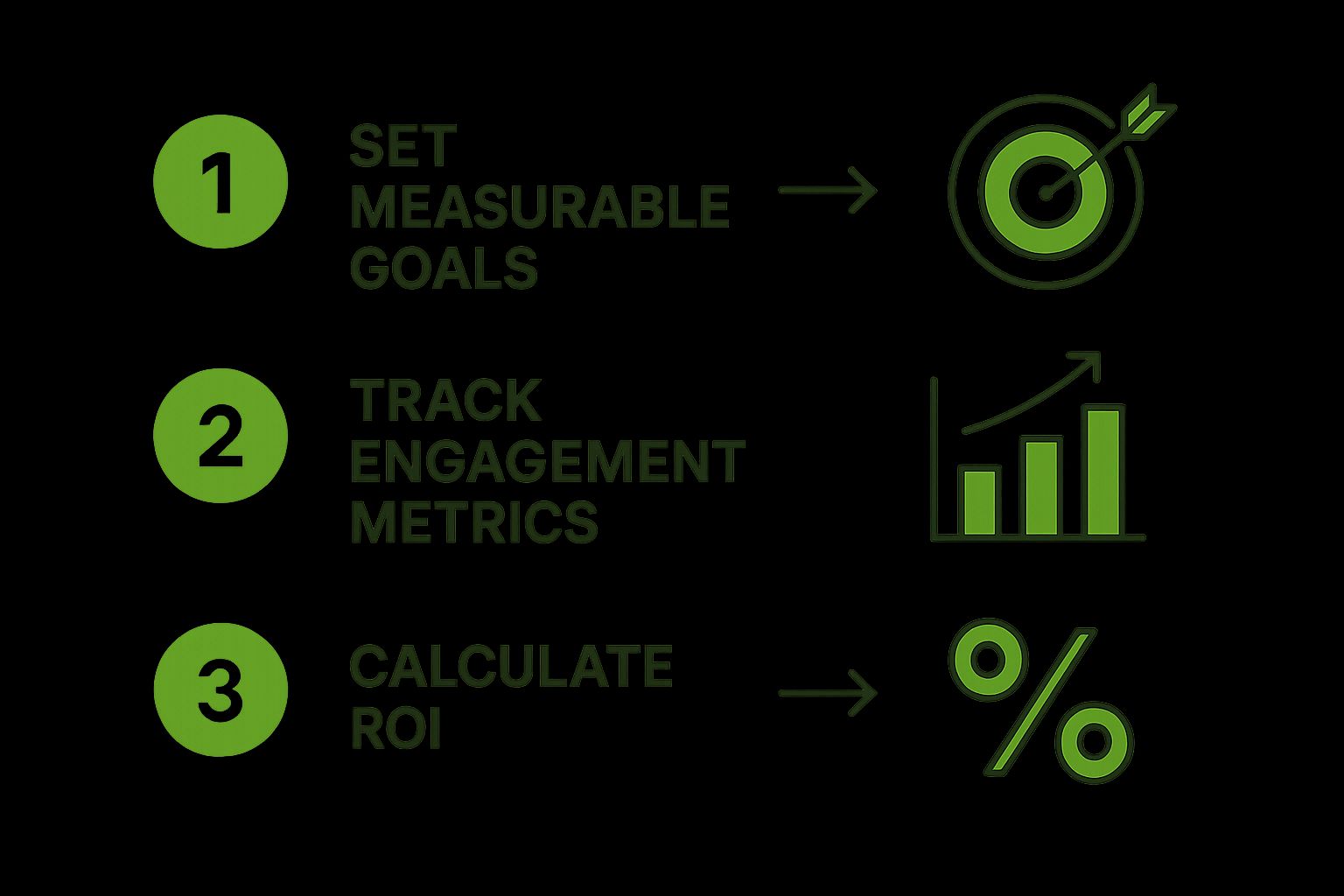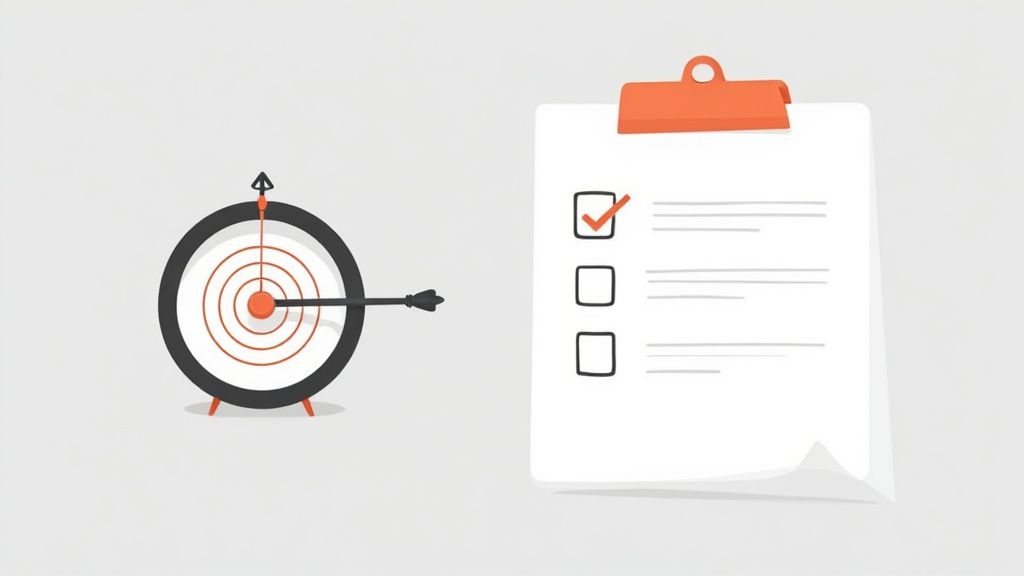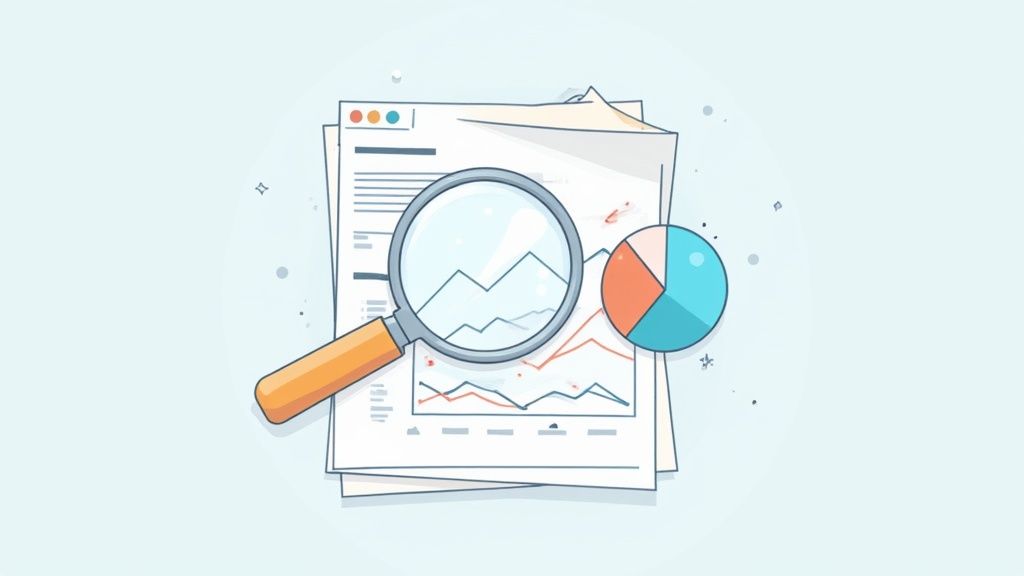Mastering Social Media Return on Investment
Think of your social media marketing like tending a garden. You wouldn't just toss some seeds on the ground and hope for the best, right? You’d carefully plant, water, and wait for a harvest. Social media return on investment (ROI) is that harvest—it’s the real, measurable business value you get back from all the time, money, and creative energy you pour into your channels.
Why Social Media ROI Matters More Than Ever

In marketing, there's a simple truth: what gets measured gets managed. While seeing a flood of likes, shares, and new followers can feel great, those numbers don't directly pay the bills. They're often called vanity metrics because they look good on the surface but don't tell you if your social media is actually growing your business.
Focusing on social media ROI forces you to shift your perspective from just being busy to creating real business impact. It’s the key to justifying your marketing budget. When you can walk into a meeting and show executives a clear financial return, you’re no longer just asking for a handout—you’re presenting a solid investment opportunity. This data-driven approach turns social media from a "nice-to-have" expense into a core revenue driver.
Moving Beyond Vanity Metrics
Tracking ROI is all about connecting the dots between your social media activities and your bottom line. It's about seeing the entire customer journey, from that first click on a TikTok video all the way to a final purchase on your website. That deeper understanding is what separates a decent social media strategy from a truly great one.
Here’s why making this shift is so important:
- Smarter Decisions: ROI data clearly shows you which platforms, campaigns, and content formats are actually delivering results. This allows you to double down on what works and stop wasting resources on what doesn’t.
- Budget Justification: When you have hard numbers, you can easily prove the value of your work and your team's contribution, making it much easier to secure the budget you need.
- Proving Profitability: It shows that your social media presence isn't just about brand awareness; it's a channel that actively generates profit for the company.
The Financial Proof in the Pudding
At this point, the profitability of social media isn't really up for debate. The numbers speak for themselves. In fact, nearly 96% of marketers report seeing positive returns from their social media efforts.
To get more specific, social ad campaigns generate an average return of around 250% on spend, which shows just how much financial potential is there. You can dig into more marketing statistics to see the full picture.
Measuring social media ROI is the bridge connecting your daily posts to your company's financial health. It translates your creative efforts into the language of business success: profit, growth, and long-term value.
Ultimately, tracking your return isn't just about crunching numbers. It's about making more intelligent, informed decisions that drive sustainable growth and prove that every single tweet, post, and story is a deliberate step toward hitting your biggest business goals.
Calculating Your Social Media ROI Without the Headache
Let's be honest, math can feel like a chore. But when it comes to your social media return on investment, the calculation is a lot less scary than it sounds. It really just boils down to a simple formula that helps you answer one critical question: are you making more money than you’re spending?
Here’s the basic formula:
(Profit from Social Media − Total Investment) / Total Investment x 100 = Social Media ROI %
It’s that simple. A positive percentage means your strategy is working and bringing in cash. A negative one is a clear signal that it’s time to rethink your approach. The real trick isn't the math itself, but getting your "Profit" and "Investment" numbers right.
This infographic breaks the whole process down into three simple steps, from setting your goals to getting that final ROI number.

As you can see, measuring ROI properly isn't just about plugging numbers into a formula. It's a process that has to start with knowing exactly what you want to achieve.
Figuring Out Your Investment
First, let's look at the "I" in ROI—your investment. This is everything you spend to get your social media running. It's not just about the ad budget; you need to account for every single cost to get a true picture.
Your total investment should include:
- Ad Spend: The direct cost of your paid ads on any social platform.
- Tools & Software: Monthly or annual fees for scheduling platforms, analytics suites, or design tools.
- Content Creation: Any money spent on photographers, videographers, copywriters, or agency fees.
- Your Team's Time: This one is easy to forget! Calculate the cost of the hours your team spends planning, creating, and managing your social media.
Add all of those up, and you have the "Total Investment" for your formula. The more detailed you are here, the more accurate and useful your final ROI figure will be.
Pinpointing Your Profit
Next up is profit, which is the "R" in your return on investment. This is all about the value you got back from your efforts. While a direct sale is the most obvious form of profit, don't forget about leads that might turn into customers down the road.
For an e-commerce business, this is often pretty straightforward. Let's walk through a quick example.
Imagine a small online shop running an Instagram campaign for a new product.
- Profit: They used trackable links and found they made $8,000 in sales directly from their social media posts and ads.
- Investment: They spent $1,500 on Instagram ads and paid a content creator $500. Their social media manager's time on this specific campaign was valued at $1,000. So, their total investment is $3,000.
Now, let's pop those numbers into our formula:
( $8,000 − $3,000 ) / $3,000 x 100 = 167% ROI
That number tells a great story. The campaign didn't just pay for itself; it generated 167% more value than it cost to run. By using this simple method, you can turn fuzzy campaign metrics into a hard number that proves the real-world value of your social media work.
Building Your ROI Tracking Toolkit
You can't measure what you don't track. To get a real handle on your social media return on investment, you need the right set of tools. Think of it as building a complete tracking ecosystem that turns fuzzy metrics like clicks and likes into cold, hard business data.
The easiest place to start is with the tools built right into the social media platforms you’re already on. Every major network, from Meta (Facebook and Instagram) to LinkedIn, has its own native analytics dashboard. These are great for a quick pulse check on your performance, showing you things like post reach, engagement rates, and follower growth—all for free.
But they have a big drawback. They keep your data locked in separate silos. This means you’re constantly bouncing between different platforms to get the full picture, which makes comparing your performance across channels a real headache.
Centralizing Your Social Media Data
This is where a good third-party social media management tool comes into play. Platforms like Sprout Social, Hootsuite, or our very own Publora are built to pull all your data under one roof. They plug into your different social accounts and bring all your important metrics into a single, unified dashboard.
Having this centralized view saves a ton of time and effort. It lets you:
- Compare performance across different platforms, side-by-side.
- Automate reporting by setting up regular updates to be sent to your team or clients. For a head start, you can check out our ready-to-use social media analytics report template.
- Analyze trends over the long haul without having to manually stitch together data from a dozen different spreadsheets.
Connecting Social Activity to Website Results
The last piece of the puzzle is connecting what happens on social media to what happens on your website—where the real business happens. This is a job for a web analytics platform like Google Analytics 4 (GA4). It's the tool that finally lets you follow the customer's journey from a social post all the way to a sale.
The secret to making this connection work is using UTM parameters. These are just little snippets of code you add to the end of your URLs. They act like breadcrumbs, telling Google Analytics exactly where each visitor came from. For instance, you can create a unique link just for a specific Instagram campaign.
Here’s a glimpse of what that traffic source data looks like inside Google Analytics.

This dashboard clearly shows which channels are sending the most users and engagement to your site. With UTMs, you can see not just that traffic came from "social," but that it came from your exact campaign, ad, or post.
This lets you attribute website conversions—like a filled-out contact form or a purchase—directly back to the specific social media activity that drove it. And that gives you the clearest possible picture of your social media return on investment.
Turning Social Engagement Into Direct Sales
Social media has grown up. It's no longer just a digital town square for chats and catching up; it's a massive, bustling marketplace. We've moved way past using it for brand awareness alone. Now, it’s a direct-to-consumer storefront where the path from seeing a product to buying it is shorter than ever.
Think about the old way of buying something online. You’d see an ad, click over to a website, hunt for the product, add it to your cart, and then finally go through the checkout process. Every single one of those steps is a potential exit point for a customer. Social commerce features, like Instagram Shopping, Facebook Shops, and TikTok Shop, have completely changed the game by squashing that entire journey into just a few taps inside the app.
Making ROI Obvious and Immediate
When customers can buy a product directly from a post or video they're watching, you eliminate the friction that loses sales. This smooth, in-app experience doesn't just bump up conversion rates; it makes figuring out where your sales came from incredibly straightforward. Every purchase made through a platform's shopping feature is a directly measurable win.
This direct sales data gives you an unmistakably clear picture of your ROI. There’s no more guesswork about which posts are actually making you money. The platform itself tells you exactly how much revenue each piece of content brought in.
Social commerce isn't just a side trend anymore—it's a global economic powerhouse. In fact, social networks are now responsible for 17.11% of all online sales worldwide. The whole sector is on track to blow past $1 trillion in annual sales by 2028.
Building Trust to Drive Purchases
To really make social commerce work for you, you have to build trust. This is where things like user-generated content (UGC) and influencer partnerships become your secret weapons for driving sales. When potential buyers see real people genuinely loving your products, it provides a level of authentic social proof that a polished product photo just can't match.
- User-Generated Content (UGC): Get your followers excited about sharing photos and videos of themselves with your products. When you feature their content on your feed, you're not just building a community; you're showing your products in a real-world setting that builds buyer confidence.
- Influencer Marketing: Working with creators who genuinely fit your brand's vibe puts your products in front of an audience that already trusts them. An endorsement from the right influencer can send your direct sales soaring through shoppable posts.
A huge piece of the social media ROI puzzle is learning how to turn that buzz and engagement into real dollars. Finding the right sales apps for boosting revenue can be a big help here. When you weave all these strategies together, you’re essentially building a powerful sales engine right within your social feeds. To truly maximize these efforts, you need to know your numbers inside and out, so be sure to master social media analytics and grow your brand.
Choosing the Right Platforms for Maximum Return
It's a simple truth, but one that's easy to forget: you can't get a great return on your social media investment if you're talking to the wrong people in the wrong place. Pouring your budget into a platform where your audience doesn't hang out is like setting up a shop in a ghost town. You have to go where your customers are.
Every social network has its own personality, its own rules of engagement, and its own audience. What works brilliantly on one platform can fall completely flat on another. This is why a "one-size-fits-all" approach to social media is a surefire way to burn through your budget with little to show for it. To really move the needle on ROI, you need to match your business goals to the platforms that are built to deliver them.
Aligning Platforms with Business Goals
Think about social media platforms like tools in a toolbox. You wouldn't grab a hammer to saw a piece of wood, right? The same logic applies here. You shouldn't try to sell trendy consumer products on a network built for professional networking. The trick is to understand what each platform excels at.
For instance, LinkedIn is the undisputed king of the B2B world. Its professional atmosphere is perfect for generating high-quality leads, establishing yourself as an industry expert, and connecting directly with decision-makers. ROI on LinkedIn is often measured in the quality of leads and the value of new client relationships, which can be massive.
On the flip side, you have visual-heavy platforms like Instagram and Pinterest. These are a dream for e-commerce brands selling anything from fashion and beauty to home decor and food. They excel at creating desire and driving product discovery through beautiful images, videos, and shoppable content. Here, ROI is often a straight line to sales and return on ad spend (ROAS).
Understanding Platform-Specific Performance
The numbers don't lie—different platforms deliver very different results. When you look at advertising performance, some channels clearly pack a bigger punch than others. For example, Facebook ads pull in a solid click-through rate (CTR) of 2.53%, making them a reliable workhorse for many businesses.
But dig a little deeper and you find some interesting nuances. Pinterest, for example, often delivers twice the return on ad spend compared to other major platforms. And then there's TikTok, which boasts an almost unbelievable 67% CTR on some of its traffic campaigns. It just goes to show how powerful a highly engaged audience can be. You can find more details in these social media advertising stats to help guide your decisions.
Choosing the right platform isn’t just about reaching the most people; it's about reaching the right people in the right context to drive the actions that matter most to your bottom line.
Platform Strengths for Social Media ROI
To make this a bit clearer, let's break down where each major platform really shines. Think of this table as a quick-start guide to matching your goals with the right channel.
| Platform | Best For | Key ROI Metric to Watch |
|---|---|---|
| Building broad brand awareness and community engagement. Driving website traffic and local business sales. | Cost Per Lead (CPL), Click-Through Rate (CTR), Conversion Rate | |
| Visual storytelling, influencer marketing, and e-commerce sales. Perfect for lifestyle, fashion, and beauty brands. | Engagement Rate, Return on Ad Spend (ROAS), Website Clicks | |
| B2B lead generation, professional networking, and establishing industry authority. | Lead Quality, Cost Per Lead (CPL), MQL to SQL Conversion | |
| X (Twitter) | Real-time news, customer service conversations, and driving timely discussions. | Brand Mentions, Engagement Rate, Customer Satisfaction (CSAT) |
| Inspiring purchases and driving traffic for e-commerce, DIY, and home decor. High-intent audience. | Return on Ad Spend (ROAS), Website Traffic, Sales Conversions | |
| TikTok | Reaching younger demographics with authentic, viral video content. Brand awareness and top-of-funnel engagement. | Video Views, Engagement Rate, Brand Mentions/Hashtag Use |
This isn't about picking just one and ignoring the rest. It’s about being strategic. By carefully selecting your channels based on your audience and what you want to achieve, you’re already setting yourself up for a much stronger social media ROI. You’re ensuring your budget is an investment, not just an expense.
Actionable Strategies to Boost Your Social Media ROI

Alright, so you know your current social media ROI. That's a huge first step. But the real question is, how do you make it better? The good news is you don't need to throw a ton of money at the problem. Improving your return often comes down to making smarter, more targeted adjustments.
One of the quickest ways to stop wasting ad spend is to get serious about your audience targeting. Dive into your analytics and figure out exactly who is engaging with your content and, more importantly, who is actually buying. Use that data to build laser-focused ad campaigns that speak directly to those people. It's a simple switch that ensures your budget is spent on reaching folks who are already inclined to be interested.
Test, Learn, and Optimize Your Approach
Social media is always in motion. What worked like a charm last month might fall completely flat today. This is why you can’t just set a strategy and forget it. To truly improve your social media return on investment, you have to be testing constantly.
A static strategy is a failing strategy. The key to boosting ROI is a relentless cycle of testing, learning from the data, and optimizing your every move based on what truly resonates with your audience.
Make A/B testing a regular habit. Running small, controlled experiments is the best way to gather real-world data on what actually drives clicks and conversions.
- Vary Your Ad Creative: Pit different images, videos, and headlines against one another. You might be surprised by which combination grabs the most attention and gets people to click.
- Refine Your Call to Action (CTA): Does "Shop Now" work better than "Learn More"? Test different button text to see which one nudges more people to take the action you want.
- Optimize Your Landing Pages: The journey doesn't end with a click. Make sure the landing page is a perfect, logical continuation of your ad's promise. A smooth transition from ad to page is crucial for turning visitors into customers.
Beyond these foundational strategies, don't overlook powerful tactics like influencer marketing, which can deliver massive returns when done right. For some inspiration, check out these influencer marketing case studies that demonstrate exceptional ROI. Each of these adjustments is a concrete step you can take right now to make your social media efforts more profitable.
Common Questions About Social Media ROI
Even with a solid formula, calculating social media ROI can feel a little fuzzy sometimes. Let's walk through some of the questions I hear most often to help clear things up.
A big one is always about tracking the "soft" stuff. How do you possibly put a price tag on concepts like brand awareness or customer trust? The trick is to link these abstract ideas to concrete actions you can measure. For example, a spike in people searching for your brand name on Google is a great sign that awareness is growing. You can also track the number of positive mentions your brand gets online.
This really highlights the difference between vanity metrics and metrics that actually matter. A huge follower count might feel good, but it doesn't pay the bills. If you want to dig deeper, we have a guide on the most important social media key performance indicators that truly show business value.
How Often Should I Be Calculating My ROI?
There’s no magic number here—it really depends on your business and how long your sales cycle is. That said, a great starting point is to review your social media ROI both monthly and quarterly.
Monthly Checks: Think of these as quick check-ins. They’re perfect for spotting whether a specific campaign is working and for making small, tactical tweaks on the fly.
Quarterly Reviews: This is where you zoom out. A quarterly look helps you see bigger trends and make smarter, strategic decisions about your budget and overall social media plan for the months ahead.
The goal isn't to get lost in spreadsheets every single day. It's about finding a rhythm that works for you—one that lets you be both responsive to what's happening now and strategic about the future.
Ultimately, just be consistent. Whether you choose to review things weekly, monthly, or quarterly, sticking to a schedule is what really matters.
Ready to stop guessing and start seeing real returns? Publora brings your scheduling, analytics, and AI-powered content creation into one place, making it easier than ever to prove and improve your social media ROI. Start your free 14-day trial today!
